2011 Great Cranberry Island Ultramarathon (Will Run for Lobster)
September 5, 2011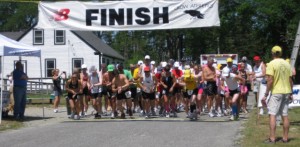 A lot of people visit Maine for the lobster. On Saturday, July 16, my wife Ruth and I, joined by more than 70 other runners and their friends, traveled in search of lobster all the way to tiny Great Cranberry Island. We found the lobster, but only after we ran the 5th Annual Great Cranberry Island 50K. Nashua NH’s Ryan Aschbrenner and Leah Thorvilson from Little Rock AR separated from the pack early on a hot afternoon and went on to set new course records.
A lot of people visit Maine for the lobster. On Saturday, July 16, my wife Ruth and I, joined by more than 70 other runners and their friends, traveled in search of lobster all the way to tiny Great Cranberry Island. We found the lobster, but only after we ran the 5th Annual Great Cranberry Island 50K. Nashua NH’s Ryan Aschbrenner and Leah Thorvilson from Little Rock AR separated from the pack early on a hot afternoon and went on to set new course records.
Great Cranberry Island is the home of co-race director Gary Allen. Gary is one of the 38 year-round residents of the island. He started the GCI Ultra partly because he’s mildly insane, and partly to help support his home island’s economy, which has fallen on hard times as the fishing industry has changed. Gary runs often enough and well enough to be one of the few people to run sub-3 hour marathons in five different decades. He somehow finds time to organize a wide array of events with co-director Mary Ropp, including the Mount Desert Island Marathon, the 61-mile July 4th Around MDI Relay, the Mud Mile, and the New Year’s Day Boston Marathon run.
The only way to get to GCI is by boat. Steve Moland, who couldn’t be there, told Gary, “I wish your events were closer, but then the charm of what you do would be lost if getting there was too easy.” The race might be hard to get to, but Gary and Mary had a first-class event waiting for us once we got there.
The island is only about a mile from where Ruth and I were staying in Southwest Harbor, so I had originally considered kayaking to the island and back. After thinking about it, I decided that fitting sore legs into a tight kayak cockpit after a 50K might not be a lot of fun. Also, a kayak wouldn’t be the easiest way to transport my gear, books, and cooler. So we decided we’d take the ferry to the island.
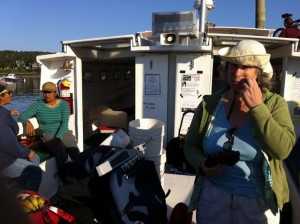 Saturday morning, Ruth and I got on the 7AM ferry from Southwest Harbor’s Upper Town Docks along with Blaine Moore, the RRCA state representative for Maine, and a few other runners. Suzanne Bracy was there to see off her friend, Jessica Willis. Suzanne wanted to run the race, but couldn’t because she was directing the Flamingo Four road race in Southwest Harbor Sunday morning. Suzanne mentioned that one of the GCI runners would be appearing at her race to sell his book. Ruth and I looked at each other and laughed before I told Suzanne, “That would be me.”
Saturday morning, Ruth and I got on the 7AM ferry from Southwest Harbor’s Upper Town Docks along with Blaine Moore, the RRCA state representative for Maine, and a few other runners. Suzanne Bracy was there to see off her friend, Jessica Willis. Suzanne wanted to run the race, but couldn’t because she was directing the Flamingo Four road race in Southwest Harbor Sunday morning. Suzanne mentioned that one of the GCI runners would be appearing at her race to sell his book. Ruth and I looked at each other and laughed before I told Suzanne, “That would be me.”
The ferry left us at the GCI dock, at one end of a 2 mile strip of road that spans the entire length of the island. That road was also the course, which made it easy to find our way to registration and the start.
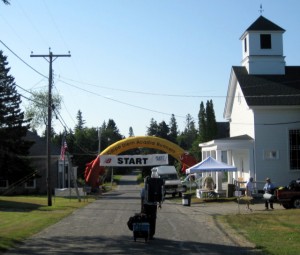 I lugged my cart full of gear and books up the half-mile climb to the Start/Finish line at the Community Center. While I walked, I got my first look at the signs that Mary designed and posted on some of the telephone poles and trees alongside the course. There was one sign for every runner, with their name and home town, mixed in with others that displayed humorous or inspirational quotes.
I lugged my cart full of gear and books up the half-mile climb to the Start/Finish line at the Community Center. While I walked, I got my first look at the signs that Mary designed and posted on some of the telephone poles and trees alongside the course. There was one sign for every runner, with their name and home town, mixed in with others that displayed humorous or inspirational quotes.
The next impressive touch was the giant archway that marked the start, an inflatable monument to running magically transferred from some big city race to the center of a small fishing village.
I parked my gear and set up my chair in the shade of the Community Center, picked up my number and t-shirt from Mary at registration table in front of the firehouse across the road, and then settled down to relax and wait. The race was set to start at 11:30, which allowed everyone time to travel to the island. It also allowed me time to look into the cloudless deep blue sky and think about how much fun we were going to have, running into the hottest part of a sunny mid-summer day.
In 2007, the original edition of the race had 21 runners, split between the 50K and a 50 mile race held (obviously) on the same course. Gary dropped the 50 miler after 2008. By 2010, the number of entrants for the 50K had climbed to 35. A video of that event submitted by 2010 women’s champion Amanda LaBelle and filmmaker Daniel Quintanilla won the Runner’s World “Best Race Ever” video contest. That helped the 2011 race reach the cap of 75 entrants by April.
All morning long, runners from across the US and Canada trickled in. In the field behind the Center, runners planning to camp overnight planted a colorful tent city, preparing to take full advantage of the infamous afterparty.
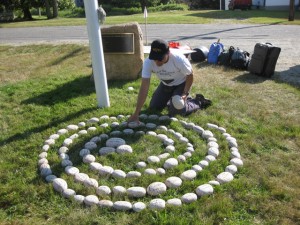 One of the prizes for each GCI finisher is a volcanic rock from the island’s shore. Each one is a unique oval, weathered round and smooth by the ocean and hand-printed with the name of the race. Gary asked me to help set them out for display. I had plenty of time to kill, so I arranged the rocks in a decorative spiral on the ground near the Center’s flagpole. After that, I grabbed an iced coffee next door at the Historical Society Café, then sat and chatted with the other runners while we waited.
One of the prizes for each GCI finisher is a volcanic rock from the island’s shore. Each one is a unique oval, weathered round and smooth by the ocean and hand-printed with the name of the race. Gary asked me to help set them out for display. I had plenty of time to kill, so I arranged the rocks in a decorative spiral on the ground near the Center’s flagpole. After that, I grabbed an iced coffee next door at the Historical Society Café, then sat and chatted with the other runners while we waited.
At about 11AM, Gary came over to the shade to give the pre-race instructions, cutting down on the time we’d spend standing in the sun at the starting line. It was hot, 80 degrees and getting hotter as the start approached, but at least it wasn’t humid. When he finished, I changed into my running shoes. I was definitely going to get salty, so I made sure I applied my BodyGlide and nipple band-aids. Then I decided I’d run in my white long-sleeved wicking shirt and shade cap for protection from the sun.
At 11:30, we all lined up at the start in the usual colorful array of gear. A number of runners were suffering in black outfits from Crow Athletics, Gary and Mary’s home club. There was also a large group wearing yellow (or pink) Marathon Maniacs singlets. Jackie Choi, one of the Mainiacs, forgot her usual running hat, so she was wearing a perky white fedora to keep the sun off her head. Another Maniac, Stephanie Arango, started the race wrapped in a pink tutu.
Gary read a selection from Chapter 1 of my book where I quote him on living and training on GCI. “When you have absolutely no option of running a different or varied loop the only decision is whether you will run or not, and how far you will go.” From the Center porch, Geoff Wadsworth played “O,Canada” on saxophone. Mary, also on sax, followed him with the Star-Spangled Banner. Finally, Gary’s son Patrick, who was sitting on a golf cart because he had broken both ankles diving off the town dock, fired a shotgun and the race was off.
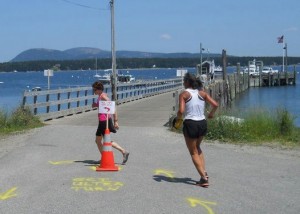 The race consists of eight loops. The first loop is a 5K out-and-back heading away from the dock toward the more sparsely settled end of the island. The next seven loops start with a half-mile run downhill to the dock. Then the runners turn, run back over the entire two-mile length of the course, turn again, and run the mile-and-a-half back to the finish.
The race consists of eight loops. The first loop is a 5K out-and-back heading away from the dock toward the more sparsely settled end of the island. The next seven loops start with a half-mile run downhill to the dock. Then the runners turn, run back over the entire two-mile length of the course, turn again, and run the mile-and-a-half back to the finish.
The ends of the course are essentially at sea level. There are two main hills between those points. One peaks near the start/finish line, and the other tops out a little under a half-mile from the far turn. Neither one is much more than 100 feet above sea level, but that’s high enough, since by the time the race is over we would climb the two hills a total of 31 times.
Running back and forth eight times on one short stretch of road made it possible for everyone to watch what was going on for the entire race. Even the slowest runner saw the leaders multiple times and we all were able to keep track of the pink tutu as it passed from one Marathon Maniac to another. New friends evolved into familiar faces with each trip across the island, faces whose cheerful smiles and waves turned to rueful grimaces in the heat. Gary made it out on the course too – there’s no way he was going to have people running on his island without jumping in for a few laps.
There was also plenty of scenery to look at while I wandered back and forth. Each loop took me from the docks, through the village, past wildflower meadows and tranquil woods. The ocean was often visible in the distance, and there were stunning views of the mountains of Acadia National Park to the north and east.
Many runners had a tough time with the sun and heat. A thermometer on the course registered in the upper 90’s in the shade. When you start a race at midday in July, that’s gonna happen. Veteran marathoner Dave Goodrich made it through 20 miles before the heat got to him and he sat down on the Community Center steps to contemplate his first DNF. Jose Viveiros collapsed by the side of the road and had to be carried back to the shade at the Center in a golf cart. His pulse was weak, he wasn’t sweating, and he couldn’t keep any fluids down, but he decided to stay and rest instead of leaving the island for treatment.
On the other hand, while it was hot, the humidity stayed away. Ty Thurlow demonstrated that conditions were probably better than the previous year. In 2010, medics had to evacuate Ty from the island to treat him for dehydration. This year, all it took was a short nap in the shade of a tree by the course, and Ty was able to get up and finish the race.
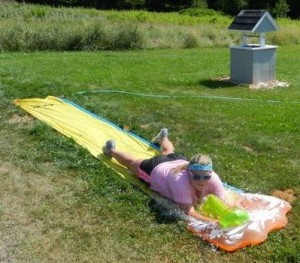 The reaction of the year-round residents to the host of people running back and forth on their turf ranged from good-natured tolerance to active support. A muscular guy named Rick Gaither was out the entire day with his small son, manning a water table and encouraging runners at the top of the far hill. The ladies nicknamed him Vin Diesel, because of his non-running physique and his shaved head. Another, unmanned, table halfway down to the dock was kept stocked all day. Islanders also cooled runners with ice, sprinklers, squirt guns, and even a Slip ‘n Slide.
The reaction of the year-round residents to the host of people running back and forth on their turf ranged from good-natured tolerance to active support. A muscular guy named Rick Gaither was out the entire day with his small son, manning a water table and encouraging runners at the top of the far hill. The ladies nicknamed him Vin Diesel, because of his non-running physique and his shaved head. Another, unmanned, table halfway down to the dock was kept stocked all day. Islanders also cooled runners with ice, sprinklers, squirt guns, and even a Slip ‘n Slide.
The residents did more than help during the race. For example, Laurie Wadsworth met Chris Jaworski and Sharon Morrissey at the ferry the day before the race, drove them to their rental, and gave them a tour of the course. Then, when the stove in Chris and Sharon’s rental failed to work, Laurie invited them to use her kitchen to cook their prerace dinner.
This was my first ultra attempt in five years because of injuries, so I wasn’t sure how I was going to do. I started out optimistically, running each lap in 33-34 minutes, but about halfway through the race, the sun helped me decide that it would be prudent to slow down and start walking up some of the hills, so my lap times jumped to 42-43 minutes apiece.
Ruth was going to work at the official water stop, but there were so many local volunteers that she was able to dedicate her time to me. That was a blessing. Every time I crossed the line in either direction, she was there with Gu, a water bottle filled with Gatorade and ice, and a terrycloth mitt soaked in icewater that I used to cool off and wipe the gritty salt from my face and neck.
For those of us who were feeling competitive, the frequent turns made it easy to tell when we were catching up with someone or if someone was coming up behind us. The extra information helped me hold off Ryan Aschbrenner on the final stretch heading for the finish line. All I did was keep him from lapping me a second time, but I’ve learned to take my victories wherever I can find them.
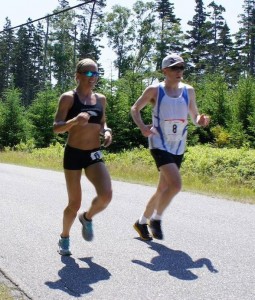 Aschbrenner and Leah Thorvilson, who are both sub-2:40 marathoners, ran together for almost half the race before Aschbrenner edged away on his way to a record 3:27:05 finish. Thorvilson’s time of 3:32 was a new Women’s record and four seconds faster than the old Men’s record. The race was also the RRCA Ultramarathon championship for Maine residents. Old Town’s Roger Marquis (4:06:19) and 2010 Woman’s winner Amanda LaBelle from Rockland (4:08:39) won their respective divisions. Roger was battling Nova Scotia’s Dave Nevitt for 4th place overall, but on the final lap Roger just couldn’t resist the Slip ‘n Slide.
Aschbrenner and Leah Thorvilson, who are both sub-2:40 marathoners, ran together for almost half the race before Aschbrenner edged away on his way to a record 3:27:05 finish. Thorvilson’s time of 3:32 was a new Women’s record and four seconds faster than the old Men’s record. The race was also the RRCA Ultramarathon championship for Maine residents. Old Town’s Roger Marquis (4:06:19) and 2010 Woman’s winner Amanda LaBelle from Rockland (4:08:39) won their respective divisions. Roger was battling Nova Scotia’s Dave Nevitt for 4th place overall, but on the final lap Roger just couldn’t resist the Slip ‘n Slide.
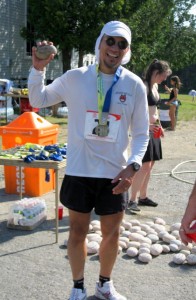 A while later I crossed the finish line for the last time. Mary gave me a medal (that doubles as a belt buckle) and my very own rock. That was it for the official awards ceremony. As Gary put it, “Some are faster but everyone is treated equally at the GCI Ultra.” I finished 15th, 3rd in my age group, in 4:53:21. All things considered, I was satisfied with my effort.
A while later I crossed the finish line for the last time. Mary gave me a medal (that doubles as a belt buckle) and my very own rock. That was it for the official awards ceremony. As Gary put it, “Some are faster but everyone is treated equally at the GCI Ultra.” I finished 15th, 3rd in my age group, in 4:53:21. All things considered, I was satisfied with my effort.
After I finished, I wanted to cool down in the ocean. A family let me hop in their car for a ride to the docks. Ruth had walked down the course to get the sign with my name as a memento, so we picked her up on the way. They dropped us off and I waded in, shivering in the 52 degree water. It was too chilly for swimming, but a great way to begin my post-race recovery.
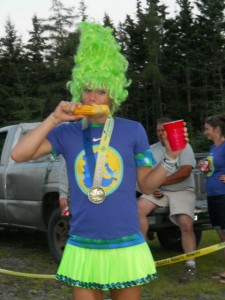 The evening shadows were finally beginning to cool the road for the runners still out on the course when the beer came out and the lobsters went into the pot. We gathered in the field behind the Community Center to eat. I helped train less experienced diners in the finer points of smashing crustacean shells with rocks to get to the tasty meat. That was almost as much fun as the sight of Leah buzzing around in a towering bright-green Seussian wig and matching skirt.
The evening shadows were finally beginning to cool the road for the runners still out on the course when the beer came out and the lobsters went into the pot. We gathered in the field behind the Community Center to eat. I helped train less experienced diners in the finer points of smashing crustacean shells with rocks to get to the tasty meat. That was almost as much fun as the sight of Leah buzzing around in a towering bright-green Seussian wig and matching skirt.
When we finished eating, we went back to the road in front of the Center to talk, drink, and watch the end of the race. Leah, still in the wig and displaying an astonishing amount of energy, and Brent Richardson, who missed the race with a sprained ankle, escorted the remaining runners through the dark to the finish.
Dave and Jose had both made it back on the course. As promised, the race stayed open and Ryan King stayed in the timing tent until they both came in. Dave finished a little after 9PM, walking the last 12 miles to stave off his first DNF.
It was a little before 10PM and Jose was just starting his final leg when Ruth and I took off to catch the last ferry back to Southwest Harbor so we could get to the Flamingo Four the next morning. Jose finished just before 10:30, freeing everyone remaining on the island to head to the Historical Society to watch “Run For Your Life”, a movie about Fred Lebow and the New York Marathon. Afterwards, it was back to the camping area to revel deep into the night.
Sunday morning, while Ruth was winning her age group in the Flamingo Four, the Great Cranberry Island Ladies Aid Society served runners a breakfast buffet with eggs, pancakes, French toast, homefries, sausage, pastries, fruit, juice, coffee, and (of course) bacon. Then everyone packed up and took the ferry back to the real world to recover from a hard day of running, and in cases like Stephanie Arango’s, “from booze… and “costume” chaffage… and from the site of Gary’s bare ass running to the ocean!”
In the days after the race, a flurry of Facebook-friending and photo-tagging helped cement the relationships built over hours of trotting back-and-forth in the sun. Many people were already thinking about returning for 2012. Gary is going to expand the field to 100 runners. He figures that’s the maximum the facilities on the island can support. Given the exceptional word-of-mouth, it’s still going to be hard to get in.
Gary and Mary founded the race to help bring attention to a fading lifestyle. They’re pleased with the results so far. Gary put it this way, “Hard as it is to run 50 kilometers, island living can be just as demanding. As year-round communities, one by one Maine’s offshore islands are going extinct. My thinking was the energy required to run so far can also help our island, and it appears to be working!”
Ray Charbonneau is the author of “Chasing the Runner’s High: My Sixty Million-Step Program”. His work has appeared in Ultrarunning, Marathon & Beyond, Cool Running, and Level Renner. For more info, visit www.y42k.com.
Add your thoughts

One Comment
Hi, just stumbled on your page from reddit. It’s not an article I would typically read, but I loved your perspective on it. Thanks for making a blog post worth reading!